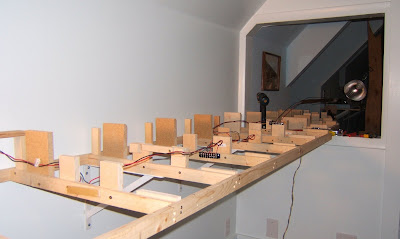Of course there are reasons Atlas code 80 is so cheap. First, it doesn't look anything like prototype track. Second, functionally speaking the slow-motion switch machines are superior to the old snap-relay variety. And third, there are valid concerns with the Atlas code 80 switches' out-of-the-box reliability.
I use Atlas code 80 in staging because: 1) prototype-like looks aren't important in staging, and 2) with 73 switches combined in my 5 staging areas the cost savings are significant. This means I had to come up with a solution to address the Atlas code 80 switch reliability problems, and that's the topic of this post.
Here is a picture of an Atlas code 80 #6 switch in package next to one that has been prepped for the layout. I've added three circles at places on the prepped switch to help with the explanation of the prep procedures. To get a bigger view simply click on the picture:

As far as I know the procedures here will also work for Atlas' smaller #4 switches. However, I recommend #6's because they are longer, with a wider curve radius, and thus more likely to operate reliability with any N scale equipment.
One point worth noting is that Atlas has improved these switches many times over the decades. Most of the chronic problems that were documented in the 1980s, for example, have been addressed in the current version. The issues that remain are addressed in the steps below:
- Open the package. The switch controller and screws can be set aside until if/when you are ready to use them for switch control. The 6 rail joiners should be separated with a cutter, such as the Xuron rail cutter, and trimmed so that there is no excess metal on the ends of each joiner. I then put them in a rail joiner drawer until they are needed on the layout.
- Inspect the switch. Look for track out of alignment and test the switch machine manually. Use a truck, such as a Micro-Trains replacement truck, to see if it catches anywhere when run over the switch. Once you've followed these procedures with several switches you'll probably be able to see the problems areas by eye without testing.
- Look closely at the rails inside the red circle in the photo above. This is where the closing rails meet the point rails. I find it helpful to use a magnifying visor for this step. In almost all cases the closing rail is not in line with the point rail (the point rail is the one which moves), but instead sticks out a little. This "sticking out" can cause trucks to skip over the bump and in bad cases can lead to derailments. Using a small metal file gently file down the side and top of the closing rail end, and if necessary the end of the point rail as well, until the transition from one rail to the next is smooth. Note that this problem usually affects the diverging route but not the straight one, but just to be safe I file the rails for both routes.
- Now inspect the plastic frog inside the yellow circle in the photo above. In some cases the frog is too big and thus can cause wheels to bump up when they travel along the frog. The solution is to file down the top of the frog tip, then file the sides of the frog tip to assure that wheels pass by smoothly all the time.
- Check the ends of the point rails (shown inside the green circle in the photo). To be honest I've not seen a problem with these in the current generation of Atlas code 80 switches, but historically the point ends can be off level with the main rails. If so you'll need to add shims under the point rails or file down the rail tops as appropriate.
- Now test the switch machine. This can be done by wiring it up per the instructions on the back of the switch package. However, to save time you can take two wires, one black and one of another color, and briefly touch them to the accessory terminals on your DC power pack. Then do the same with the other color wire and the black wire. Test only once, to avoid overheating the switch machine. Again, I've not experienced any out-of-the-box problems with this generation of Atlas code 80 switch machines, but if a problem does arise I want to find it before I install the switch on the layout
- Finally, as the switch wires are short you'll probably need to extend them. I strip about 3/8" of insulation off each wire and crimp yellow butt splices (gauge 16-22, as shown in photo) that are found at Radio Shack. I don't add wire to the other side of the butt splice until the switch is on the layout, as until that time you won't know how much additional wire will be needed.








